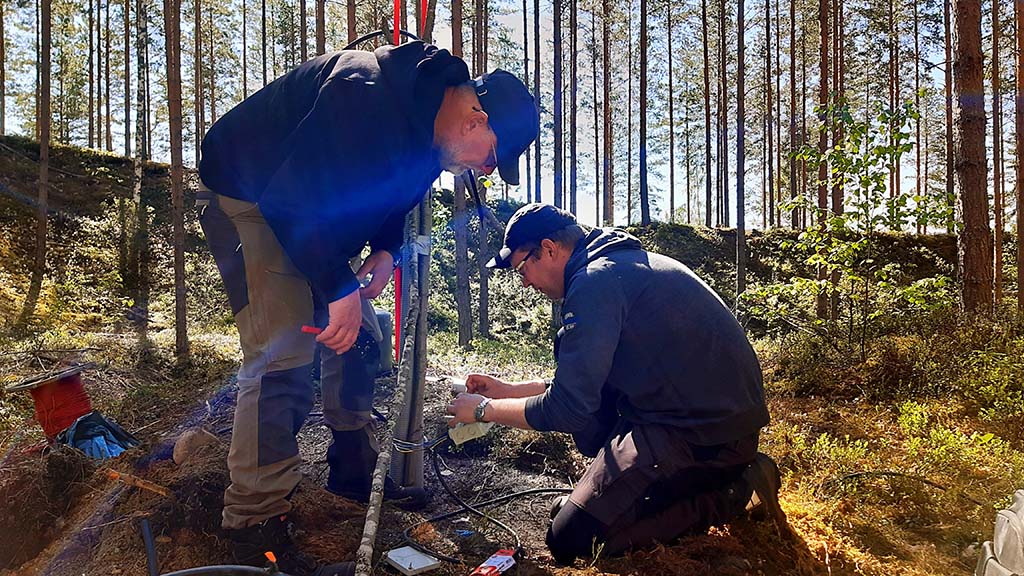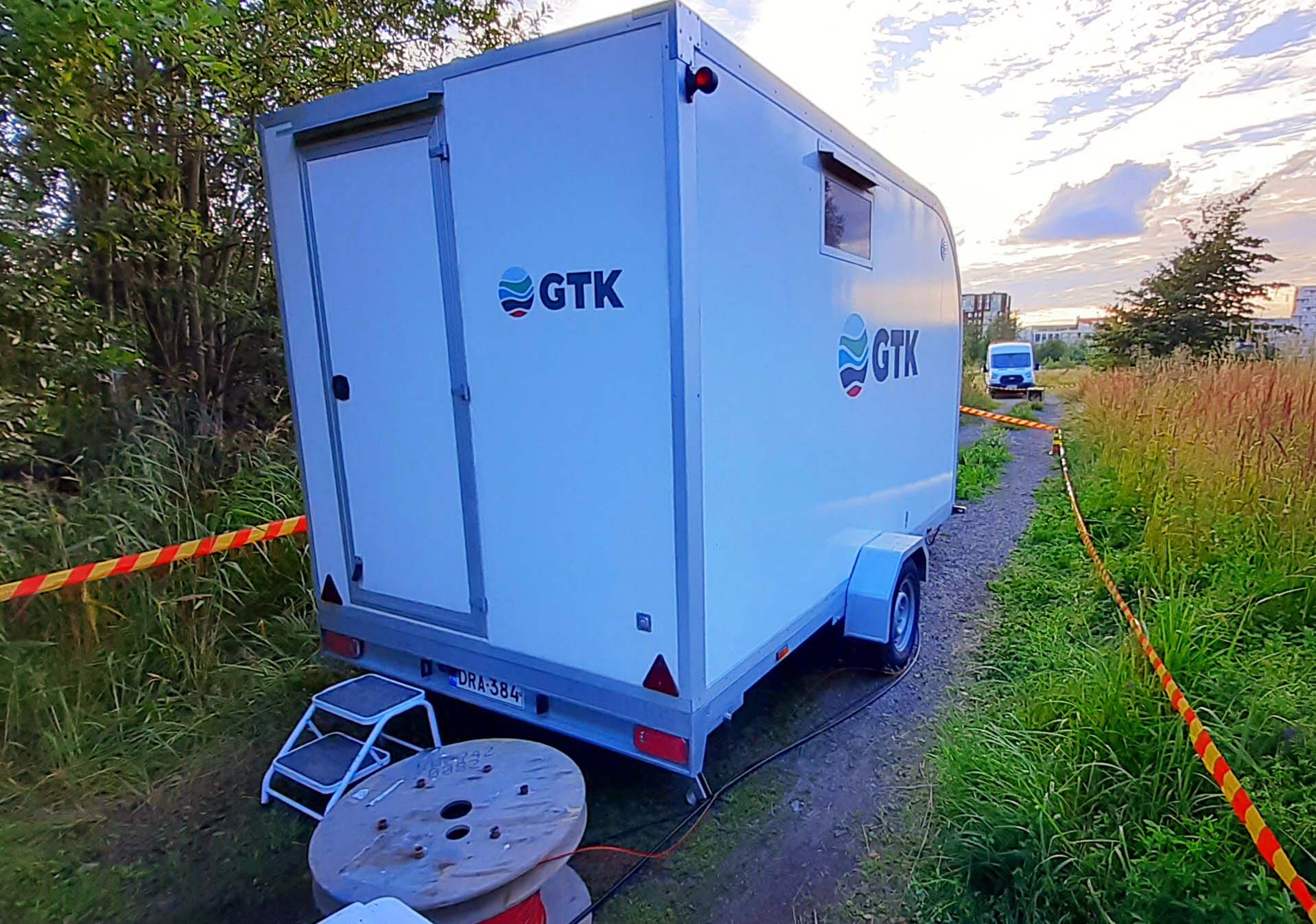Bedrock Thermal Conductivity Research Bolstered with a Geoenergy Trailer and the ADTS Heat Pulse Method
The Geological Survey of Finland’s (GTK) new geoenergy trailer serves as a mobile base and can be used for active distributed temperature sensing (ADTS), among other measuring methods. ADTS is a novel method in which hybrid fibre-optic cable is used to determine the thermal conductivity of bedrock. The versatile method can also be used to collect data on rock type variation, bedrock fracturing, and water-conducting layers in porous soil.

In ADTS, bedrock is heated with an electric current fed with the desired power into copper wires running inside a hybrid fibre-optic cable, and the optical fibres are used to monitor the change in the bedrock temperature. The method is an advanced form of traditional distributed temperature sensing (DTS), in which the bedrock’s natural temperature is monitored, and the collected data are used to determine the temperature profile of the bedrock relative to depth.
A traditional DTS instrument simultaneously measures the bedrock temperature for the entire length of the fibre-optic cable. Bedrock temperature can be determined from the surface to the bottom of the borehole with just one measurement. The novel ADTS method produces even more versatile temperature data, because it allows the net thermal conductivity for the entire length of the borehole to be determined. ‘We have used ADTS for most of the measurements we have carried out with the new geoenergy trailer,’ says Researcher Petri Hakala from GTK.
The geoenergy trailer has no fixed instruments; instead, it is loaded with the instruments needed case by case. An engine generator is used to power the instruments. This enables measurements to be carried out at remote locations with no access to electricity. The new geoenergy trailer is notably larger than its predecessor, and has lighting, heat, ventilation and more space for working.
‘We’re very pleased with the opportunities the new geoenergy trailer brings. We can now splice the optical fibres inside, and we don’t need to leave any instruments outside the trailer. This also reduces the risk of hazardous situations,’ says Mikko Pelkkala, Research Assistant at GTK.
Geoenergy Trailer Enables Temperature Monitoring On-site
Bedrock thermal conductivity is one of the key factors to be determined when designing an energy solution based on geothermal heat. Thermal conductivity measures the rate at which heat is transferred in bedrock, and it is essential in designing borehole heat exchanger (BHE) fields.
Measurements must be taken at one to five locations usually, depending on the site. For example, for the SOK retail logistics centre in Sipoo, five thermal response tests were carried out that each included the bedrock thermal conductivity to be determined. The data were used to model the size of the BHE field required for the property. Most of the logistics centre’s BHEshave permanently installed fibre-optic cables that are used to monitor the energy system during its operation in real time and to control the BHE field based on bedrock temperature. GTK Researcher Ilkka Martinkauppi was responsible for designing the monitoring system.
‘In practice, measuring bedrock thermal conductivity with ADTS takes three days. We’ve learned that this is enough time to determine how heat is conducted within the bedrock,’ Hakala says.
If the measuring time is too short, most of the heat fed into the bedrock goes to heating the water inside the borehole. The geoenergy trailer enables monitoring bedrock temperature on-site, and measuring results are saved in real time. After the measurements are made, the data is interpreted and models created.
The measuring operation always requires two experts, and preparations must be carried out carefully. ‘First, we lower the fibre-optic cable into the drill hole or BHE and splice the fibre-optic cables. We attach the fibre optic connectors to the cable; this ensures we can direct laser beams into the borehole. Then we connect the fibre optic connectors to the measuring instrument,’ Pelkkala explains.
The DTS instrument’s temperature measurements are not absolute. This means a calibration must be carried out to correct the measured temperature. Usually, only a minor correction is required. The measurement accuracy of the DTS instrument is around 0.1 °C. Preparations take time, because the correction must be made separately for each measurement.
‘Newer DTS instruments have proved to work well with the fibre-optic cable we use. We have even successfully measured a 2-kilometre, or medium-deep, borehole. We could measure even deeper boreholes,’ says Hakala.
The new instrument enables the temperature to be measured every 25 centimetres for the entire length of the cable. This creates an extremely accurate bedrock temperature profile. The instrument is so precise that it also enables to collect other important data. With a sufficient measurement time, ADTS can be used to locate bedrock fracture zones and changes in rock type.

Only GTK Uses ADTS in Finland
The ADTS method of hybrid fibre-optic cable benefits many of GTK’s services and research areas. The method can be used to locate bedrock fractures that conduct water and to assess the waterflow rate in porous soil. New collaboration has emerged between the fields of energy, construction and water management. For example, in GTK’s Hydrogeology and the Global Change project, ADTS is being developed to enable monitoring soil waterflow.
Research and experiments continuously lead to new discoveries on the versatility of the method. ADTS has been tested in surveying dam structures and monitoring the efficiency of bioleaching. Both DTS and ADTS can also be carried out in urban environments. For example, a model can be made to assess the number of BHEs required for a site based on measurements of the thermal conditions of soil and bedrock and energy demand information.
DTS has been in use for several years now, but ADTS is a relatively novel method, and research on it is still scant. In Finland, GTK is the only operator carrying out ADTS measurements. Globally, ADTS is used to some extent in Germany and France, for example.
‘We’ve just published an article related to ADTS, called ′Novel use of the enhanced thermal response test in crystalline bedrock’. We’ve waded a little way out into the water, but there’s still a lot to study. We have a good basis in terms of measurements and interpretation, but each new measurement increases our understanding of and skills with the method,’ concludes Hakala.
Additional information
Nina Leppäharju, Team Manager
Energy and Construction Solutions, Geoenergy
nina.leppaharju@gtk.fi
Related topics
- Synopsis and a download of the entire article (PDF) in ScienceDirect: Novel use of the enhanced thermal response test in crystalline bedrock
- DTS method in an urban Positive Energy Building (PEB):
Urban Geothermal Energy and Positive Energy Buildings - DTS method in the geothermal energy solution for a carbon neutral university campus:
Aalto University Campus & Real Estate – Towards a carbon neutral campus with geothermal energy - Introduction to the Hydrogeology and the Global Change project:
Hydrogeology and the Global Change (HYGLO)
